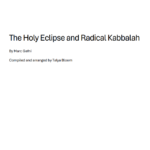The Holy Eclipse and Radical Kabbalah
By Marc Gafni
Compiled and arranged by Talya Bloom
Dedication
To My Holy partner, Dr. Kristina Kincaid, who read Radical Kabbalah word for word and in her reading and being and teaching re-minded the Sun and the Moon.
– Marc Gafni
>>>Download the PDF of this Essay<<<
April 8, 2024 – Complete Solar Eclipse in the US, corresponding with New Moon for month of Nisan
Overview
On April 8, 2024 parts of North America experienced a complete solar eclipse. The cosmological phenomenon, when engaged from a mythological perspective, invites us to a conversation on the nature of the sun and the moon and their relationship to each other. As in many traditions, the moon in esoteric Hebrew wisdom represents the feminine, and the sun, the masculine. From a human perspective, during a solar eclipse, the sun and moon seem to be equal in size. The mystical implications of this are discussed in esoteric lineage tradition of the Wisdom of Solomon.
The solar eclipse coincided exactly with the molad, the “rebirth” of the moon, on the eve of the New Moon of the month of Nisan.
The juxtaposition of these two cosmological events invites us to a close study of lineage sources discussing the relationship between the sun and the moon, the masculine and the feminine, poles of the Godhead and Sefirotic relationships.
In these Midrashic and Zoharic sources we will learn a multi-staged model of evolution of the feminine which was developed by Isaac Luria and democratized by Mordechai Lainer, and which provide a useful frame of reference for our times.
3 Stage Midrashic Tradition: Mi’ut HaYarei’ah and Nesira
Luria outlines a seven-stage process called tikun ha-nukva, the repair of the feminine which emerges from two distinct midrashic traditions:
- The first source is the well-known text in the Babylonian Talmud which describes the moon complaining to God about sharing her glory with the sun.
For Luria, mi’ut ha-yarei’ah, the diminishment of the moon, is the fundamental flaw in the cosmos which must be reversed and rectified.
- The second midrashic text, conflated by Luria with the moon story, is the story of the creation of the first, androgynous human, which is divided in two in order to be ultimately reunited at a higher level.
This source delineates three distinct stages in the relationship between the first man and woman:
- The initial androgynous unity of male and female, which exist back-to-back in one body
- The nesirah or separation of the male and female halves from each other
- And finally, the ability of man and woman after they are separated to turn to face each other, panim bepanim, ‘face-to-face’.
These three stages correspond to the moon’s evolution:
- The initial state corresponds to the state of the moon before she complains to God
- This unity is broken when the moon becomes smaller as a consequence of her complaint
- And ultimately, this unity will be restored at a higher level, represented by the moon in its fullness.
7 Stage Zoharic tradition, Eitz Hayyim sources: Zeir Anpin and Nukva
Luria further divided these three stages into a total of seven stages, discussed in Eitz Hayyim Shaar 36 ch. 1, 42, where Luria posits that in the eschaton the moon will attain her initial stature and even exceed it.
Elaborating on the Zohar, Luria tells the story of the relationship between the two partzufim, Ze‘ir Anpin and Nukva, or Man and Woman through these midrashim. Ze‘ir Anpin is the partzuf at whose center is Tif’eret, and Nukva is Malkhut/Shekhinah.
Eitz Hayyim, which records Luria’s teachings, describes Nukva’s recovery from her diminishment, identifying seven stages, which are subdivided into the three stages discussed above, regarding the growth of the partzuf of nukva or ‘Woman’—the personification of Shekhinah energy—in the context of her relationship with the partzuf of Ze‘ir Anpin or ‘Man’.
At the end of the process of tikun, she stands in equal height to the masculine partzuf, Ze‘ir Anpin. Until Tikun ha- Nukva is effected, she is unable to draw down the consciousness or mohin (lit. ‘brains’) which is hers and must receive this through the mediation of Ze‘ir Anpin, while afterwards, she draws her consciousness directly from the great mother, from Binah.
In Luria’s image, the degree of dependency is expressed in spatial terms. The shorter she is, the greater the degree of dependency on Ze‘ir Anpin; the taller she is, the more she incorporates into her self and the more self-sufficient she becomes. Besides height, Luria applies a second evaluation to the level of Nukva’s growth and unfolding: the movement from a relationship that is back-to-back to one that is face-to-face. The messianic goal is for Nukva to achieve an independent, face-to-face relationship, equal in stature, with Ze‘ir Anpin.
- The first three stages are back-to-back corresponding to the midrashic description of the androgynous human being.
- After nesirah takes place, nukva initially regresses back to a single point from which she grows in three successive stages, until she is once again of equal height to Ze‘ir Anpin; this time, however, she is in a relationship to Ze‘ir Anpin which is face-to-face.
- After the nesirah, even though nukva can turn towards Ze‘ir Anpin, she cannot come face-to-face with Ze‘ir Anpin until their statures become equal in the sixth and seventh stages. This entire process for Luria is essentially the cycle of sihara, the moon.
Intermediate conclusions
In these sources we note the evolution of the feminine energy[1] which occurs during a solar eclipse.
Co-incidence with New Moon of Nisan (Passover is on Full Moon of Nisan – 15 Nisan)
First we shall adduce a midrash specifically regarding the New Moon of Nisan:
On the first of Nisan the moon begins to shine, and she continues to shine until the fifteenth of Nisan, when her disk becomes filled. From the fifteenth until the thirtieth, her light wanes. On the thirtieth, she cannot be seen. So too, is Israel: from Abraham until Solomon there are fifteen generations. Abraham began
to shine, as it is said, ‘Who aroused one from the East…’ (Isa. 41:2). When Solomon came [after thirteen intervening generations], the moon’s disk became full, as it is said, ‘And Solomon sat on the throne of the Lord as king’ (1 Chron. 29:23).
The New Moon of Nisan is therefore regarded as an auspicious time for the “evolution of the feminine”.
Returning to the seven stages in Luria’s theory of the evolution of the feminine,
Luria positions the sixth stage of the process in historical time.
This is the secret of what is written in the Zohar on parshat Emor (3:112) on the fifteenth of the month, that then the moon is in her fullness…Such is the case on the night of Passover, the fifteenth of the month, for then she turns face-to-face with him, according to the sixth previously mentioned aspect…She then immediately returns to her former state.
In stage six, the two partzufim are of equal height. While this stage is initially reached during the Exodus, it is achieved on a continual basis—that is to say not only on Shabbat but also during the week—only at the time when Solomon builds the Temple, the time when the moon was always in its fullness.
The month of Nisan is therefore conducive to the evolution of the feminine energy.
Conclusion
The juxtaposition of the solar eclipse and the new moon of Nisan provide a nexus in time, Kairos, which humankind can leverage at a stage in history in which we are called forth to evolve our consciousness.
A pre-eschaton possibility – Mordechai Lainer
According to Luria, the seventh stage, which is that of two kings sharing the same crown, was not and will never be achieved until the future eschaton. If it had been so during the time of the First Temple, no nation or other tongue could ever again have ruled over us.
While Luria says clearly that the messianic stage, stage seven, is not accessible within pre-eschaton history, for Lainer, stages six and seven to some extent collapse into each other. According to Lainer, unmediated face-to-face encounter with the Shekhinah is a genuine possibility within the present.
The reader is invited to contemplate the ways in which he or she is called to participate in the harmonizing of the feminine and masculine poles of Reality.
L’Shem Yichud Kud’sha Brich’Hu U’Shechinteh
>>>Download the PDF of this Essay<<<
Footnote
[1] “The evolution of the feminine” is not in any way meant to denigrate the masculine energy in the world, nor is it co-identical with gender. Rather, the move is towards restoration of a greater degree of awareness of and harmony between the masculine and feminine poles in all aspect of Reality, in full honor and appreciation of both.








